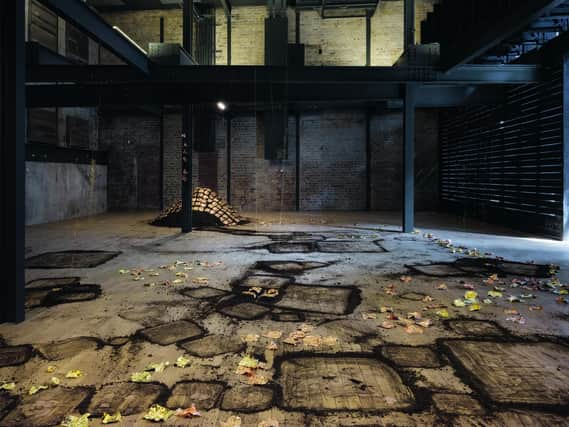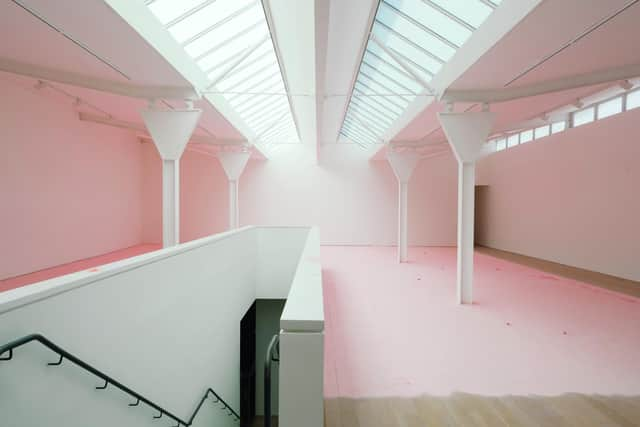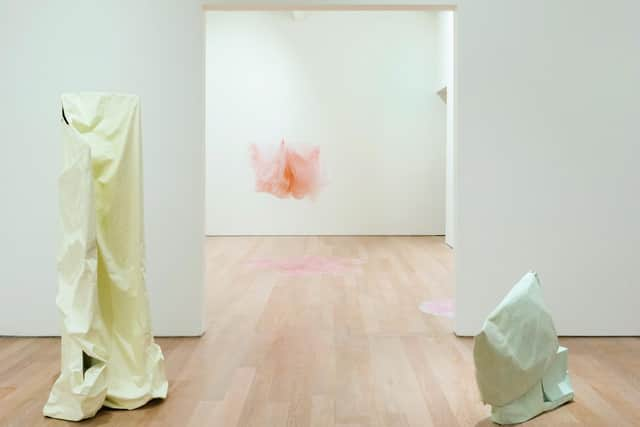Art review: Karla Black, Fruitmarket Gallery, Edinburgh


Karla Black: Sculptures (2001-2021) – Details for a Retrospective, Fruitmarket Gallery, Edinburgh ****
One of the much anticipated events postponed by the pandemic is the reopening of the Fruitmarket Gallery after a £4.3 million redevelopment. Almost a year later than originally planned, and two years after it closed, the reopening of the gallery while the dregs of Covid still linger feels both like an act of defiance and a milestone on the road towards recovery.
Advertisement
Hide AdAs redevelopments go, it’s a game of two halves. The original gallery has a new staircase, new walls, new lighting, but differences are subtle. The work of architects Reiach and Hall has been to refresh rather than redesign, while adding new facilities like better access and a dedicated education space.


What’s new is that the building next door, the former Electric Circus nightclub, originally a fruit and veg warehouse, is now part of the gallery. Here, the emphasis has been on stripping away the interior, including the mezzanine floor, returning the building to its brick-lined, steel-framed bones. Former joists and floorboards have been recyled to wall off the main space from the windows creating a raw, dark, post-industrial feel.
This doubles the floorspace of the gallery and creates a space which will be used for live events, once they become possible again, as well as exhibitions. While building on its long heritage as a gallery for modern and contemporary art, this marks a shift for the Fruitmarket (covid-permitting) towards a more diverse life as a contemporary arts space.
Part of the original plan for reopening was to host an exhibition by Karla Black throughout the building. Black brings together existing and remade works going as far back as 2006 (including some from her show for the Venice Biennale in 2011, curated by the Fruitmarket), and makes a new site-specific commission for the new space, demonstrating different ways of working in each of the three galleries.
The main gallery downstairs is busily full of sculptures from the past 15 years, most of which have been remade; Black’s signature materials - sugar paper, cellophane, cosmetics – don’t make for long-lived art. Even the more solid-looking objects which have survived in their original form are made from nothing more solid than polystyrene.


Black is resistant to any discussion of what these works “mean”, insisting they have no reference points outside themselves. Instead, we are intensely aware of her materials, their fragility, their provisionality. Cardboard structures seem ready to totter, as if a breath of wind might blow them over, cellophane forms to crumple, polysterene towers to topple.
Advertisement
Hide AdEverywhere, there is evidence of playful experimentation. Surfaces are smeared and daubed with moisturiser, nail varnish, vaseline, spray tan. The predominant colours are pinks, baby blue, lemon yellow. Gaviscon is poured in a circle on the gallery’s pristine new floor; it dries and flakes off in a beautiful mosaic of leaf-like shapes.
If everything feels as if it’s on the verge of dissolving, collapsing, blowing away, this is completely intentional. This is art which is not about the object but the process, the instinctive, animalistic moment of creativity when the works were made. In fact, Black seems almost to feel as if any resolution would kill this creative energy. She keeps her work precarious, unresolved because that’s what it takes to keep it alive.
Advertisement
Hide AdThe upper gallery is occupied by just one work – Punctuation is pretty popular: nobody wants to admit to much (with Black, titles tend not to help a lot) – which covers the floor with pink plaster dust. Over it, Black has tossed reels of pink and red thread which leave their gossamer traces. A baby doll pink hue falls over the whole space, and one is tempted to crouch at the edge of it as one might by a great, still lake.
This is the conundrum of Black’s work: it’s insubstantial, an hour or two with a dustpan and brush and it would be gone. Yet it can have a transformative quality, as if she has understood the properties of the space absolutely, and decided to make those properties plain in a new and rather magical way.
She does this again in the former nightclub space with the new commission, Waiver For Shade. The opposite to the upper gallery, it is dark, grungy, earthy, and so she makes work with earth. She builds piles of it, and draws shapes on the floor with it, reminiscent of an old house when the furniture is finally moved and the spaces where objects sat are ringed with dust. Then she adds fine gold thread which catches the light like a gilded spider’s web, and shiny scraps of gold and copper leaf.
While this is the first time Black has brought together older works, everyone involved in the show is clear that this is not quite a retrospective; that would require too much resolution, it would kill too much. In a similar way, there is a very real sense in which these works are not quite sculptures. They have not been worked up into sculptures, they are still in a fluid state.
I’m in two minds about Black’s work, have been for a long time. It is fundamentally unresolved, and that can be unsatisfying. The materials, for the most part, remain untransformed: cellophane is still cellophane, eye shadow is still eye shadow. There are no metaphors; these works aren’t trying to reach beyond themselves or say anything about the world. If the energy is in a kind of play, the artist is clearly having a lot more fun than we are.
On the other hand, we recognise the truth in impermanence, particularly in a year which has seen statues smashed and certainties of all kinds in freefall. There is something powerfully resonant about tiny things which glint in darkness, which might be thrown away sweetie papers, but might just turn out to be gold.
Until 24 November
A message from the Editor
Advertisement
Hide AdThank you for reading this article. We're more reliant on your support than ever as the shift in consumer habits brought about by coronavirus impacts our advertisers.
If you haven't already, please consider supporting our trusted, fact-checked journalism by taking out a digital subscription at https://www.scotsman.com/subscriptions